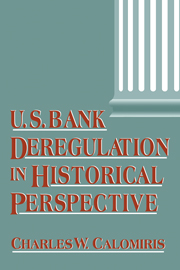Book contents
- Frontmatter
- Contents
- Acknowledgments
- Introduction
- 1 Regulation, industrial structure, and instability in U.S. banking: An historical perspective
- 2 The origins of banking panics: Models, facts, and bank regulation (with Gary Gorton)
- 3 The origins of federal deposit insurance (with Eugene N. White)
- 4 The costs of rejecting universal banking: American finance in the German mirror
- 5 The evolution of market structure, information, and spreads in American investment banking (with Daniel M. G. Raff)
- 6 Universal banking, “American style”
- General Index
- Index of Names
4 - The costs of rejecting universal banking: American finance in the German mirror
Published online by Cambridge University Press: 11 September 2009
- Frontmatter
- Contents
- Acknowledgments
- Introduction
- 1 Regulation, industrial structure, and instability in U.S. banking: An historical perspective
- 2 The origins of banking panics: Models, facts, and bank regulation (with Gary Gorton)
- 3 The origins of federal deposit insurance (with Eugene N. White)
- 4 The costs of rejecting universal banking: American finance in the German mirror
- 5 The evolution of market structure, information, and spreads in American investment banking (with Daniel M. G. Raff)
- 6 Universal banking, “American style”
- General Index
- Index of Names
Summary
Introduction
The American financial system has been an outlier internationally in virtually every important respect for the past century. It has been the most geographically fragmented and the most susceptible to financial crises (Calomiris and Gorton 1991; Calomiris 1993). It has been among the most restrictive of combinations of financial services within intermediaries, although in recent years some of these restrictions have begun to be relaxed (Kaufman and Mote 1989, 1990). The American system has also been the most persistently innovative financial system in the world. Often, important innovations have been induced by regulatory restrictions that raised the cost of finance under preexisting financial technology.
These observations are commonplace. Other unusual aspects of American financial history have received less attention, including the relative lack of bank involvement in industrial finance, the heavy reliance on corporate bonds as a means of finance, the high costs of securities underwriting, and the high cost of capital in American industry.
The main goal of this paper is to weave these peculiar features of the American system into a single interpretive tapestry. The central argument of the paper is that regulatory limitations on the scale and scope of banking in America hampered financial coordination and substantially increased the cost of capital for industrialization, particularly in the period of the growth of large-scale industrial enterprises prior to World War I. This may seem a strange claim in light of American growth and financial innovativeness.
- Type
- Chapter
- Information
- U.S. Bank Deregulation in Historical Perspective , pp. 212 - 279Publisher: Cambridge University PressPrint publication year: 2000
- 10
- Cited by



